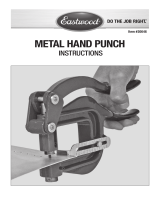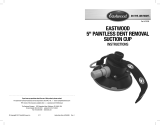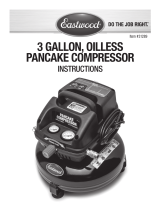Page is loading ...

BRAKE BLEEDER/
VACUUM TOOL
INSTRUCTIONS
Part #30178

2 Eastwood Technical Assistance: 800.544.5118 >> techelp@eastwood.com
The EASTWOOD 16 PIECE BRAKE BLEEDER/VACUUM TOOL set includes multiple adapter
fi ttings and hoses to allow use on virtually any car, SUV or light truck brake caliper or cylinder.
Constructed with a high-quality composite body and machined brass cylinder for long life and
brake fl uid resistance. The bourdon tube type vacuum gauge will read up to 30 in Hg [760 mm Hg]
of vacuum for performing accurate vacuum diagnostics on many vehicles.
CONTENTS
(1) Brake Bleeder/Vacuum Tool.
(1) Reservoir Jar.
(1) Reservoir Lid (For Bleeding).
(1) Reservoir Lid (For Storage).
(2) 23" x 1/4" I.D. [584mm x 6.4mm] clear Vinyl Hoses.
(2) 3" x 1/4" I.D. [76mm x 6.4mm] clear Vinyl Hoses.
(1) Barbed 3 way, “Tee” Hose Connecter.
(1) Barbed Hose Connecter.
(2) Tapered Bleeder Adapters.
(2) 5/16" I.D. [7.8mm] Bleeder Adapters.
(1) 1/4" I.D. [6.4mm] Bleeder Adapter.
(1) Flat Suction Adapter.
(1) Blow Molded Case

To order parts and supplies: 800.345.1178 >> eastwood.com 3
SAFETY INFORMATION
WARNING indicates a hazardous situation which, if not avoided, could result in death or serious injury.
CAUTION used with the safety alert symbol, indicates a hazardous situation which, if not avoided,
could result in minor or moderate injury.
READ INSTRUCTIONS
Thoroughly read and understand this manual before using.
Save for future reference.
IMPROPER MOTOR VEHICLE BRAKE WORK
CAN RESULT IN INJURY OR DEATH!
• Performing brake work without adequate training on motor vehicle brake
systems can cause injury, death and vehicle accidents. DO NOT attempt to
use this tool or begin motor vehicle brake work without proper training and
a thorough understanding of motor vehicle braking systems.
• Always consult an authorized service manual on the particular vehicle for
the proper brake bleeding procedure before using this tool.
FAILURE TO PROPERLY JACK & SUPPORT
A VEHICLE CAN RESULT IN INJURY
OR DEATH!
• The Eastwood Brake Bleeder/Vacuum Tool must be used only on properly
jacked and supported vehicles by properly trained individuals with thorough
knowledge of automotive braking systems.
• Failure to use on a properly supported vehicle can result in serious bodily
injury and property damage.
• Always consult an authorized service manual on the particular vehicle for
the proper jacking/supporting procedure before using tool.

4 Eastwood Technical Assistance: 800.544.5118 >> techelp@eastwood.com
EXPOSURE TO AUTOMOTIVE BRAKE FLUID
CAN BE A HEALTH HAZARD!
• Be sure to follow all precautions listed on the brake fl uid container
before using.
• Wear NIOSH approved eye protection while handling brake fl uid and
during the bleeding procedure.
• Wear appropriate automotive brake fl uid resistant gloves while handling
brake fl uid and during the bleeding procedure.
EXPOSURE TO AUTOMOTIVE BRAKE DUST
CAN BE A HEALTH HAZARD!
• Wear a NIOSH approved respiration protection device while handling
brake components and during the bleeding procedure.
• Wear NIOSH approved eye protection while handling brake components
and during the bleeding procedure.
• Wear appropriate automotive brake fl uid resistant gloves while handling
brake components and during the bleeding procedure.

To order parts and supplies: 800.345.1178 >> eastwood.com 5
1. Twist to release the Reservoir Jar from Reservoir Lid and slip one of the 3" x 1/4" I.D.
[76mm x 6.4mm] clear Vinyl Hoses over the molded plastic nipple on the underside of
the Reservoir Lid then reattach the Reservoir Lid and turn to lock in place.
2. Slip a 3" x 1/4" I.D. [76mm x 6.4mm] clear Vinyl Hose over the brass fi tting at the end of
the Brake Bleeding/Vacuum Tool.
3. Push the opposite end of the 3" x 1/4" I.D. [76mm x 6.4mm] clear Vinyl Hose over one of
the molded plastic nipples on the top of the Reservoir Lid.
4. Attach an end of the 23" x 1/4" I.D. [584mm x 6.4mm] clear Vinyl Hose over the opposite
molded plastic nipple on the Reservoir Lid.
5. Choose the appropriate sized Bleeder Adapter or Tapered Adapter that best fi ts over the O.D.
or inside I.D. of the particular bleeder fi tting in use. Slip the open end of the 23" x 1/4" I.D.
[584mm x 6.4mm] clear Vinyl Hose over the chosen fi tting. NOTE: The 2nd 23" x 1/4" I.D.
[584mm x 6.4mm] clear Vinyl Hose may be connected to the 1st if additional length in
required by using the supplied Barbed Hose Connecter.
TOOL ASSEMBLY FOR BRAKE BLEEDING

6 Eastwood Technical Assistance: 800.544.5118 >> techelp@eastwood.com
TOOL ASSEMBLY FOR GENERATING VACUUM
1. Slip the 23"x 1/4" I.D. [584mm x 6.4mm] clear Vinyl Hose over the brass fi tting at the end
of the Brake Bleeding/Vacuum Tool.
2. Push the opposite end of the 23" x 1/4" I.D. [584mm x 6.4mm] clear Vinyl Hose over the
appropriate Tapered Fitting for insertion into a vacuum port or directly onto a suitably sized
vacuum port. NOTE: The 2nd 23" x 1/4" I.D. [584mm x 6.4mm] clear Vinyl Hose may be con-
nected to the 1st if additional length in required by using the supplied Barbed Hose Connecter.
Additionally, a split vacuum source can be created by using the included “Tee” Fitting.
TOOL USE FOR BRAKE BLEEDING
• Generally, the brake farthest from the master cylinder is bled fi rst (usually right rear) and
successively closer wheels are done however it is extremely important to consult a service
manual on the particular vehicle being worked on before beginning any work.
NOTE: Automotive brake fl uid can quickly damage paint if spilled. Use extreme care.
• With the vehicle properly jacked and supported, thoroughly clean the brake bleeder fi tting
to prevent foreign material from entering.
• Following the vehicle manufacturers instructions, open and fi ll the master cylinder with
fresh brake fl uid.
• Slip the clear Vinyl Hose with the tightest appropriately fi tting Bleeder Adapter over or inside
the vehicle’s bleeder fi tting.
• VERY IMPORTANT STEPS:
- Be sure the Vacuum Release Valve (black knob on underside of brass pump body)
is securely closed.
- Begin pumping action to create maximum vacuum as displayed on the gauge.
- Once vacuum is accumulated, loosen the vehicle bleeder fitting slightly to open it and
allow the vacuum to draw out fluid and air from the brake system.
- Carefully observe the fluid being drawn though the clear tubing for air pockets. When the
moving fluid becomes solid with no air pockets visible, the vehicle Bleeder Valve may be
closed.
• Depending on the amount of air present and size of the caliper or wheel cylinder, the above
steps may need to be repeated one or more times until a solid column of fl uid is present in the
tubing. If repeating is required, be sure to:
- Fill Master Cylinder.
- Be sure the vehicle bleeder is closed.
- Pump up vacuum.
- Open Bleeder to withdraw brake fluid.
- Close Bleeder.
• Fill the master cylinder with fresh brake fl uid and following the vehicle manufacturer’s instruc-
tions for the proper sequence, progress to each successive wheel until all air is removed from
the system.

To order parts and supplies: 800.345.1178 >> eastwood.com 7
TOOL USE FOR VACUUM DIAGNOSTICS
• Slip the clear Vinyl Hose with the tightest appropriately fi tting Bleeder Adapter over the
O.D. or inside the I.D. of an appropriate vacuum port.
• Be sure the Vacuum Release Valve (black knob on underside of brass pump body) is
securely closed.
• Begin pumping action to create required vacuum as displayed on the gauge.
• Check for proper vacuum component operation per vehicle manufacturers instructions.
• Vacuum may be released by rotating the Vacuum Release Valve (black knob on underside
of brass pump body) to the open position.
TROUBLESHOOTING
PROBLEM CAUSE CORRECTION
Gauge Swings
Left and
Quickly Goes
to Zero After
Pumping
Vacuum Release
Valve not closed
Be sure Vacuum Release Valve (black knob
on underside of brass pump body)
is securely closed.
Vehicle brake bleeder
valve is open
Brake bleeder valve MUST BE CLOSED
to allow vacuum to build before opening
bleeder valve.
Tool WIll Only
Draw a Small
Amount of
Fluid
Vacuum Release
Valve not closed
Be sure Vacuum Release Valve (black knob
on underside of brass pump body)
is securely closed.
Vehicle bleeder fi tting
not open enough
The vehicle bleeder fi tting needs to open
slightly more to allow the accumulated
vacuum to draw out fl uid and air from the
brake system.
Dirt or debris may
be blocking bleeder
outlet
Remove bleeder completely to clean out.
Brake bleeder may
be open too much,
allowing air to be
drawn in around
threads
Partially close bleeder valve.
Remover bleeder valve and add a minimal
amount of Tefl on tape to threads.

© Copyright 2015 Easthill Group, Inc. 11/15 Instruction item #30178Q Rev 0
If you have any questions about the use of this product, please contact
The Eastwood Technical Assistance Service Department: 800.544.5118 >> email: techelp@eastwood.com
PDF version of this manual is available online >> eastwood.com/30178manual
The Eastwood Company 263 Shoemaker Road, Pottstown, PA 19464, USA
US and Canada: 800.345.1178 Outside US: 610.718.8335
Fax: 610.323.6268 eastwood.com
TROUBLESHOOTING
PROBLEM CAUSE CORRECTION
Air Bubbles
Will Not Stop
Appearing in
Fluid Column
Vacuum Release
Valve not closed
Be sure Vacuum Release Valve (black knob
on underside of brass pump body)
is securely closed.
Brake bleeder may
be open too much,
allowing air to be
drawn in around
threads
Partially close bleeder valve.
Remover bleeder valve and add a minimal
amount of Tefl on tape to threads.
Bleeder Threads
May Have Loose
Tolerances
Remover bleeder valve and add a minimal
amount of Tefl on tape to threads.
Brake Fluid Low
Check master cylinder for fl uid and fi ll
if empty.
/






